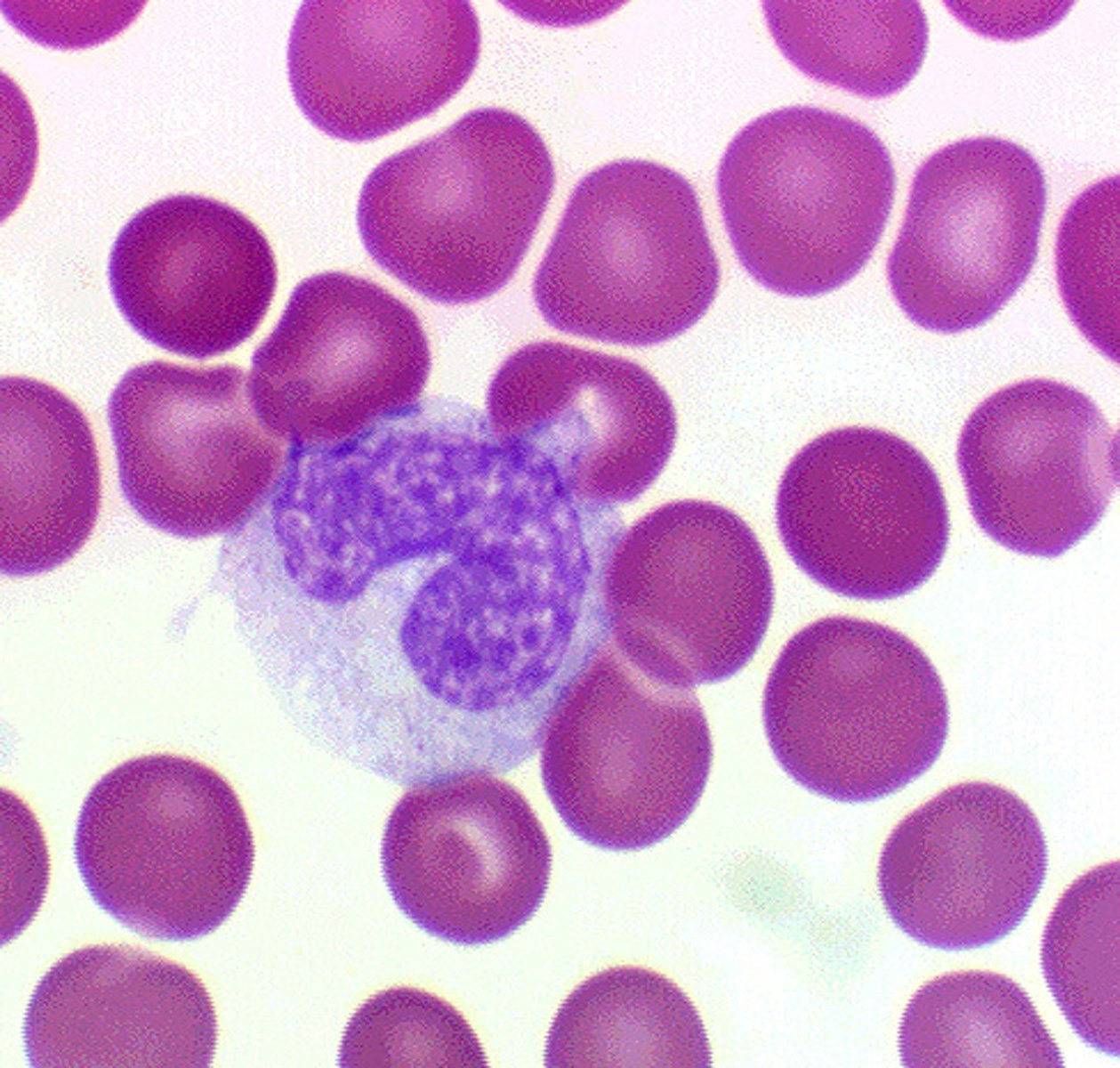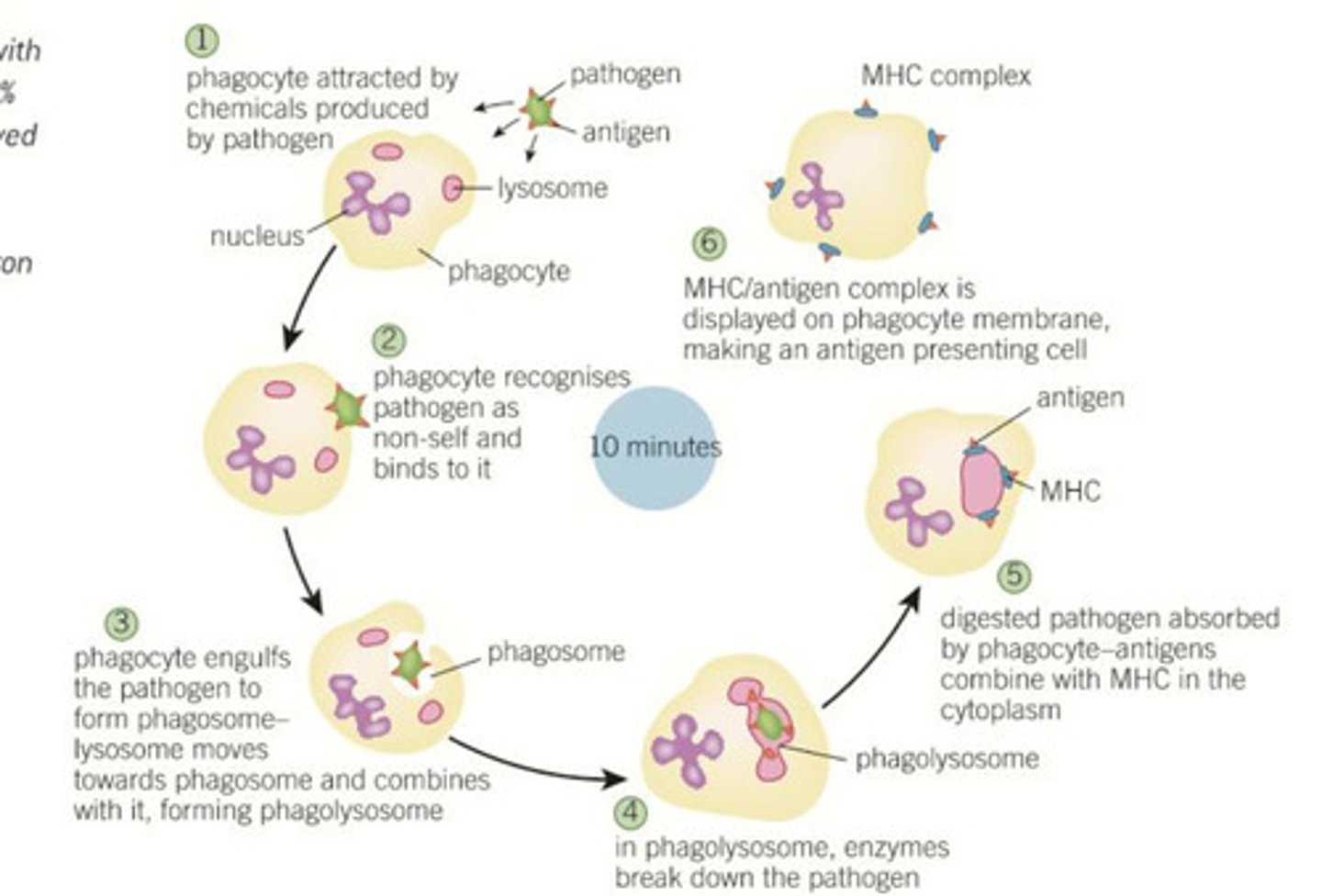Biology - Chapter 12.5: Non-specific animal defences against pathogens
1/29
There's no tags or description
Looks like no tags are added yet.
Name | Mastery | Learn | Test | Matching | Spaced |
|---|
No study sessions yet.
30 Terms
How does the skin act as a barrier?
-Has skin flora of healthy microorganisms that OUTCOMPETE pathogens for space on body surface
- Produces sebum, oily substance inhibiting growth of pathogens
How do body tracts at as a barrier to pathogens?
- Are lined by mucous membranes, that secretes mucus
- Mucus contains phagocytes, removes remaining pathogens
- Traps microorgransisms
- Contains lysozymes which destroy bacterial and fungal cell walls
What is lysozyme present in?
Tears, urine
Why is the stomach pH being low beneficial?
Denatures pathogen's proteins
What does the large intestine contain?
Normal flora that outcompete pathogens
Rapid pH change from stomach to upper intestine (1st section of small intestine)
pH 1 --> 8 denatures pathogen's proteins
What is thromboplastin?
An enzyme that triggers a cascade of reactions, resulting in the formation of a blood clot
- Catalyzes reaction of prothrombin + Ca2+ --> thrombin
What is serotonin's role in blood clotting & wound repair?
- Makes smooth muscle in walls of blood vessels contract
- They narrow & reduce supply of blood to the area (slows its flow)
Process of blood clotting and wound repair?
1. Collagen in skin exposed
2. Platelets adhere to collagen & change config.
3. Platelets secrete substances that via a cascade of events, result in the formation of fibrin
which itself forms a network, trapping platelets & forming a clot
What is thrombin?
enzyme that converts fibrinogen to fibrin during coagulation
- Fibrin forms clot
- Collagen fibers added = strength
How to know when wound is healed?
Scab sloughs off
What cells do inflammatory response use?
Mast cells
- Are activated in damaged tissues & release chemicals histamines & cytokines
What do histamines do?
- Dilate blood vessels, causing localized heat & redness
- Raised temp prevents pathogens from reproducing ; denatures pathogen's proteins
- increases FLOW of blood to the infected area & increases PERMEABILITY of blood vessels.
- Antibodies, WBCs (phagocytes) & blood plasma leak out into infected tissue (cause swelling & pain) & destroy pathogen
What do cytokines do?
- Act as cell-signaling molecules
- Attract/ stimulate WBCs (phagocytes) to site
- Dispose of pathogens by phagocytosis
- Increase body temp
- Stimulate specific immune system
What are expulsive reflexes and how are they beneficial?
- Coughs & sneezes eject pathogen-laden mucus from gas exchange system
- Vomiting & diarrhoea expel contents of gut & any infective pathogens
How do cytokines help when there is a fever?
- When a pathogen invades the body, cytokines stimulate the hypothalamus to reset the thermostat & temp goes up
- Pathogens reproduce best at or below 37 degree Celsius (higher temps inhibit pathogen reproduction)
- Specific immune system works faster at higher temps.
What does pus consist of?
Dead neutrophils and pathogens
Features of macrophages?
- Round nucleus
- Bigger than neutrophils
- Move in blood & stay in fixed areas
- 4% of all WBCs
- Slower response

Neutrophils
- Multilobed nucleus (allows them to fit through small sites of infection)
- Travel all the time in blood
- 70% of WBCs
- Rapid response < 12 hrs
- Many lysosomes
- Many mitochondria

Stages of phagocytosis
1. Pathogen produces chemicals that attracts phagocytes
2. Phagocytes recognize non-human proteins in pathogen (response not to specific pathogen, only to cell/organism that is 'not-self'
3. Phagocyte engulfs pathogen (cytoskeleton used to move cell membrane around pathogen) & encloses it in phagosome (vacuole)
4. Phagosome combines w. lysosome, forming phagolysosome
5. Enzymes from lysosome digest & destroy pathogen

When and how do macrophages become APCs?
- When it has digested pathogen , it combines antigens from pathogen surface membrane w. glycoproteins in cytoplasm called MHC complex
- MHC complex moves pathogen antigens to macrophage's surface membrane
- These antigens simulate other cells involved in specific immune system response
What is phagocytosis?
Process by which WBCs engulf pathogens thus destroying them by fusing a pathogen enclosed in a phagocytic vacuole w. a lysosome
When are cytokines produced?
Once pathogens have engulfed a pathogen
What are opsonins?
chemicals that bind to pathogens and 'tag' them so they can be more easily recognized by phagocytes
Increase likelihood of phagocytosis
Explain how cytokines make the process of phagocytosis more effective
Cytokines act as cell signaling molecules that stimulate phagocytes to move to a site of infection or inflammation
Explain how opsonins make the process of phagocytosis more effective?
Opsonins bind to pathogens & tag them so they are more easily recognized by phagocytes because phagocytes have receptors on their membranes which bind to common opsonins e.g. antibodies
What do macrophages do?
Digest pathogens
Trigger specific response
What do neutrophils do?
Kill and digest pathogens
What cells are involved in phagocytosis?
Macrophages, neutrophils, APCs, lysosomes, phagosomes
Explain the function of epithelial cells in the airways of mammals in the defence against pathogens & suggest the importance of the cytoskeleton in carrying out this function
goblet cells, secrete mucus
mucus traps, pathogens / microorganisms / bacteria
ref. phagocytes / neutrophils / macrophages / lysozyme
cilia waft away mucus
cytoskeleton / microtubules / tubulin, move(s) / make(s) up, the cilia